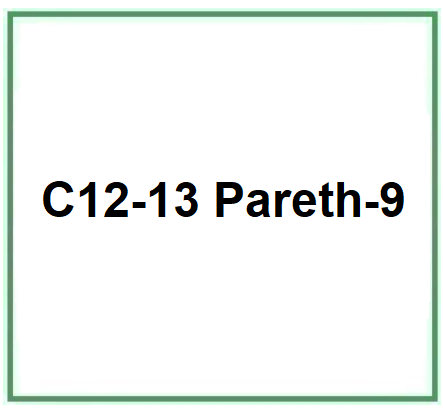C12-13 Pareth-9 is a chemical compound, an alkyl polyethylene glycol (PEG (Polyethylene glycol)) ether mixture of synthetic C12-13 fatty alcohol ethoxylated (9 mol).
The name describes the structure of the molecule:
- C12-13 indicates the alkyl chain length, which can vary between 12 and 13 carbon atoms.
- Pareth is a term used to denote a polyethylene glycol (PEG) ether of a fatty alcohol.
- -9 indicates the degree of ethoxylation, meaning the average number of ethylene oxide units in the molecule.
Raw Materials Used in Production.
- Fatty alcohols originally derived from natural sources such as vegetable or animal oils.
- Ethylene oxide is a chemical compound used to produce ethoxylates, which are typical of pareths.
Step-by-step Summary of Industrial Production Process.
- Extraction of fatty alcohols. Fatty alcohols are extracted from natural sources.
- Ethoxylation reaction. The fatty alcohols react with ethylene oxide to form an ethoxylate.
- Purification. The product is purified to remove impurities and byproducts.
Form and Color.
C12-13 Pareth-9 typically appears as a clear viscous liquid.

What it is used for and where
Cosmetics
Surfactant - Emulsifying agent. Emulsions are thermodynamically unstable. Emulsifiers have the property to reduce the oil/water or water/oil interfacial tension, improve emulsion stability and also directly influence the stability, sensory properties and surface tension of sunscreens by modulating their filmometric performance.
Surfactant - Cleansing agent. Cosmetic products used to cleanse the skin utilise the surface-active action that produces a lowering of the surface tension of the stratum corneum, facilitating the removal of dirt and impurities.
CAS: 66455-14-9
Commercial applications
Cosmetic Industry. C12-13 Pareth-9 is commonly used as an emulsifying or solubilizing agent in cosmetic products, particularly in cleansers, shampoos, and other skin and hair care items. Due to its emulsifying properties, it helps to blend water-based ingredients with oil-based ones, creating a uniform texture in products. It can also aid in the distribution of other ingredients within the formula. It is easily soluble in both water and oily compounds, making it useful across a wide range of cosmetic formulations.
Safety.
The term 'eth' in Pareth refers to the ethoxylation reaction with ethylene oxide after which residues of ethylene oxide and 1,4-dioxane, chemical compounds considered carcinogenic, may remain. The degree of safety therefore depends on the degree of purity of the compound obtained. At present, no manufacturer is known to provide this information on the label.
![]() C12-13 Pareth-9
C12-13 Pareth-9 

